Despite What You’re Being Told, China Is Dying
China, you’ve been told, is a rising power. Soon, you’ve been told, they’ll surpass the United States as the center of a new world order. Their annual gross domestic product averaged 9% growth from 1989 to 2022; their standing military has 2 million active personnel; their tentacles reach into Africa, the Middle East, and South America. The real story of China is far, far scarier, because China is a power in a state of inevitable collapse. The only question is when, and how much damage they’ll do, before the Chinese regime implodes. That’s because China has at least five serious problems.
Problem #1 | Demographics
China is currently, according to geopolitical strategist Peter Zeihan, the fastest-aging society in all of human history. A healthy demographic chart, in terms of age, looks something like a pyramid: most of the citizens will be young, a solid number will be middle-aged, and at the very top, the fewest will be elderly.
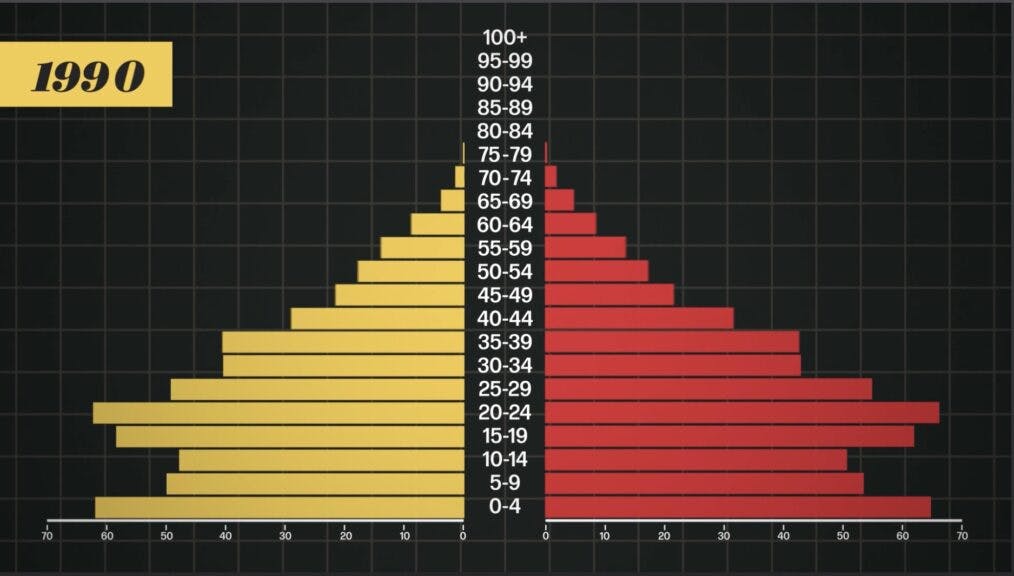
Even in 2000, the warning signs were clear in China. You can see the dramatic lack of people in the 9 and below group. That did not change.
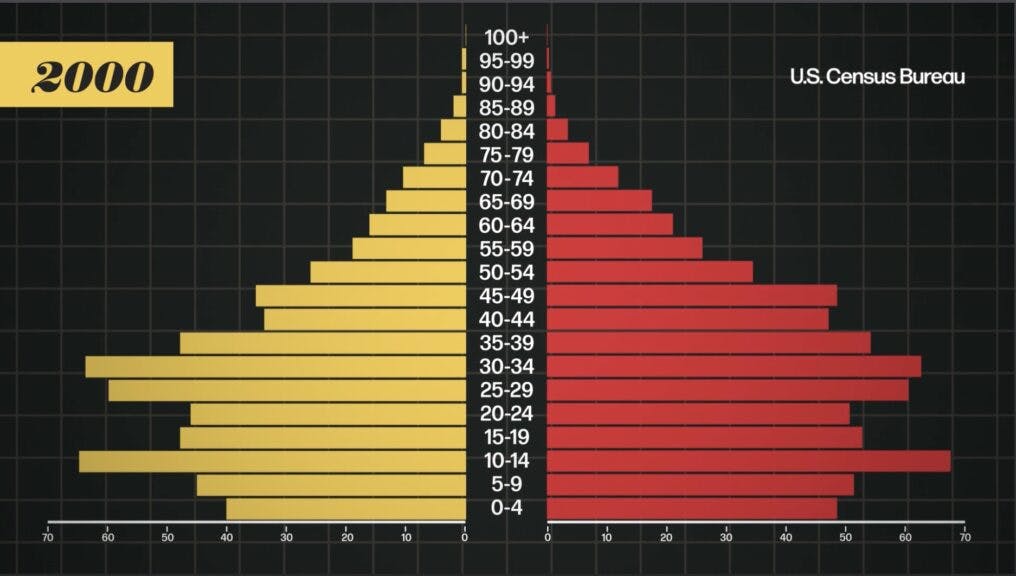
So here’s what that same chart looks like by 2020. Look at how the vast bulk of the population is now over the age of 30. There is no supporting demographic base to pay all the bills. This is why Zeihan says China now has a “completely terminal demography.”
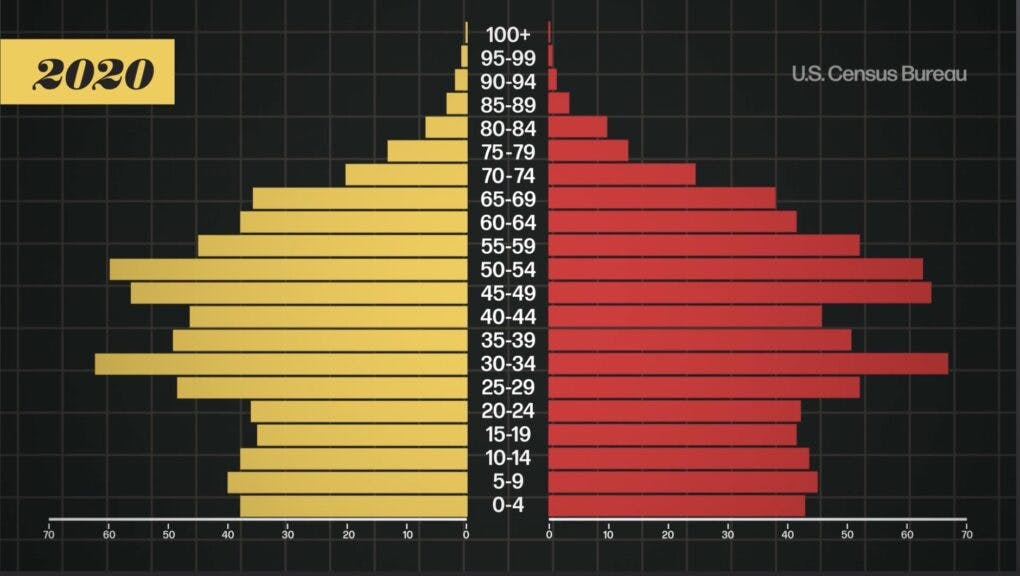
China currently has a birthrate of less than 1.2 per woman. It’s worse in urban areas.
The decline of Chinese birthrates can be attributed to two factors: first, the Chinese government’s evil one-child policy, implemented in 1980, ended in 2016, it resulted in three to four percent more boys than girls being born thanks to sex-selective abortion and infanticide; families literally killing off female babies in the womb or afterward.
According to the Chinese government itself, the one-child policy prevented 400 million births. China’s population has already peaked — it’s now dropping. The question is as the population ages in a heavily Marxist system, who is going to pay the bills?
Problem #2 | Lack Of Innovation
This brings us to problem number two: lack of innovation. If China were free, you know, an innovative, robust economy, it might be possible to stave off disaster for at least a little while. After all, the generation of new products and services might allow China to thrive economically in the short term, that would buy time for the social system to transition away from high levels of government support and toward something more sustainable. But China has no innovation, thanks to its state-controlled mercantilist schemes. Right now, the entire Chinese economy is reliant on producing things at scale, undercutting foreign markets, and stealing technology. As the young working population declines, producing things at scale becomes a lot more difficult. Cheap labor goes away.
China is trying to fill the gap right now with robotics. In 2021, China represented 52% of global worldwide industrial robot installation. There is a problem with this. If a robot can do a job more cheaply than a human, why produce in China at all as opposed to somewhere that isn’t a geopolitical hellhole run by an authoritarian communist government? Furthermore, China has to import all those robots, largely from Japan.
And then there’s the problem of innovation. It turns out when you nationalize all innovation, you kill it. The solution is to rob everyone else of their IP and then try to recreate it. Some reports suggest that Chinese IP theft costs the United States up to $600 billion per year. This is an unsustainable growth model. It always leaves Chinese IP well behind Western IP. They’re stealing somebody else’s technology and then they’re trying to reengineer it. This is particularly true when it comes to microchips, where China manufactures a lot of basic microchips, but has actually been cut off from the world’s markets for sophisticated microchips. All of which brings us to the third problem: debt.
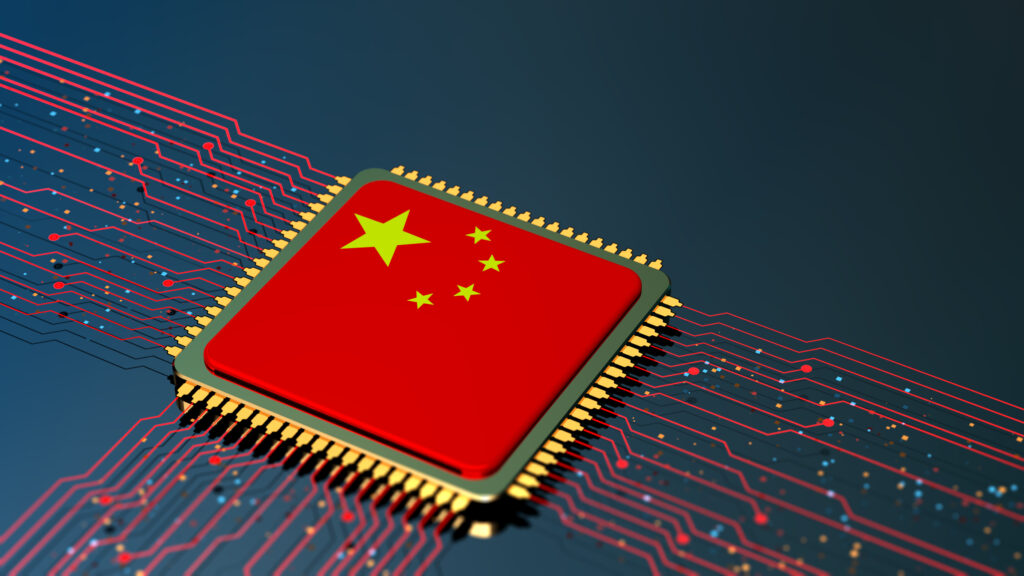
MF3d. Getty Images.
Problem #3 | Debt
If you can’t pay for things through innovation or through manufacturing, you got to get a lot of money from someplace else. Well, China’s growth has been disproportionately funded by debt. The country’s debt to GDP ratio is at least 159%, that is 60% higher than the global rate, according to the S&P Global Ratings. The nation’s total stock of corporate, household, and government debt is now over 300% of GDP. It comprises 15% of all debt globally, according to the Institute of International Finance.
Because Chinese banks are owned by the state, their decision making is rooted in government interests rather than profitability, that means they are probably carrying trillions of dollars in bad loans. As Professor Antonio Graceffo writes, “It is extremely unlikely that the Chinese Communist Party will be able to solve all of these problems or completely turn the economy around. The Chinese economy is too big and too complex to be able to remedy the deeply ingrained issues that have become endemic.”
The best visible example of China’s economic hollowness is its ghost cities. Literally cities that are just empty. China is chock filled with these so-called “ghost cities,” they include, apparently, up to 65 million empty units of housing.
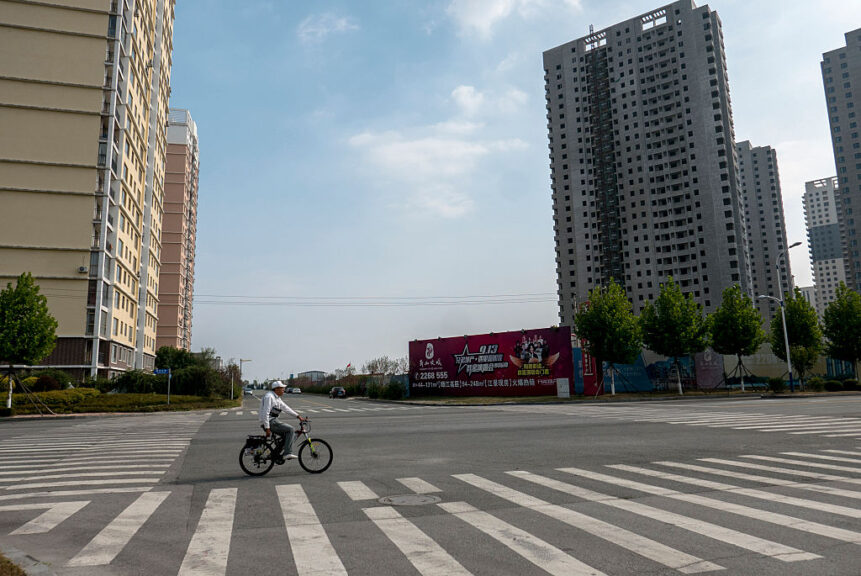
Zhang Peng/LightRocket via Getty Images
Why did this happen? Well, politicians borrowed insane amounts of money for make-work projects, with the government then encouraging people to put their retirement money into buying empty shells of apartments, assuring them the prices would continue to rise. This has generated a looming real estate catastrophe. Because none of these apartments are livable. But Chinese citizens keep putting their money in real estate because it allows them the illusion of actual ownership of something — and in a communist country, even the illusion of ownership is better than the reality that the government runs everything and you don’t own anything.
Problem #4 | Military
China has yet another problem: Military problems. Now, everybody thinks China is a powerful military country, and they kind of are. But, with China on the brink economically and demographically, they might be expected to get more aggressive militarily. And again, China does keep threatening surrounding areas, including most prominently, Taiwan. China’s 2 million man army is indeed huge. But, manpower isn’t everything, as we saw in the Ukraine War. And like Russia, the Chinese military isn’t up to snuff. China relies on older, less sophisticated chips, according to the RAND Corporation. The United States has worked to control import of chips into China, which means that their Chinese tech is just not as good as American military tech.
The United States has even prevented Chinese companies from receiving software updates, spare parts, or technological input from Americans.
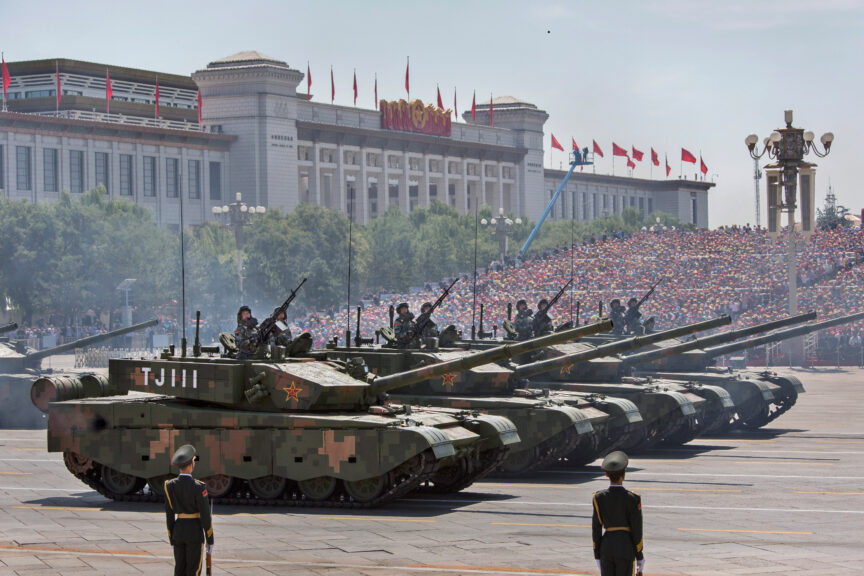
Kevin Frayer/Getty Images
According to Chris Miller, author of Chip War, China now lags the United States by up to a decade. What’s more, China doesn’t yet have the capacity to project deep water power. They have a lot of boats in their Navy, and their Navy is effective in coastal zones, but they have no capacity to project power beyond those zones. Which means that Taiwan and the South China Sea are squarely in China’s crosshairs – because 92% of all sophisticated microchips are produced in Taiwan, we could see China attempt to blockade the island with the threat of destroying TSMC, Taiwan’s microchip manufacturing company.
Problem #5 | Dictatorship
Finally, you have problem number five: dictatorship. Underlying all of these other problems is the biggest one of all: China is a one party dictatorship. While fools like Thomas Friedman of The New York Times write that “China’s one-party autocracy can impose the important policies needed to move a society forward” the reality is the reverse: because the dictatorship is the be-all end-all, it can’t allow the freedom and innovation necessary to grow the country and fix its problem. Instead, dictator Xi Jinping, in an attempt to enshrine his own power, has doubled down, seeking more economic control, more autarky, greater militarism, more carbon-based fossil fuels to push manufacturing growth.
China is in very serious trouble. Does this mean that China is going to break apart into a million policies? No. But it means that the current regime is on shaky footing. And that means they are likely to get very aggressive in the near term, in an attempt to shore up their foundation. Because if they don’t, that collapse is going to happen sooner rather than later.

